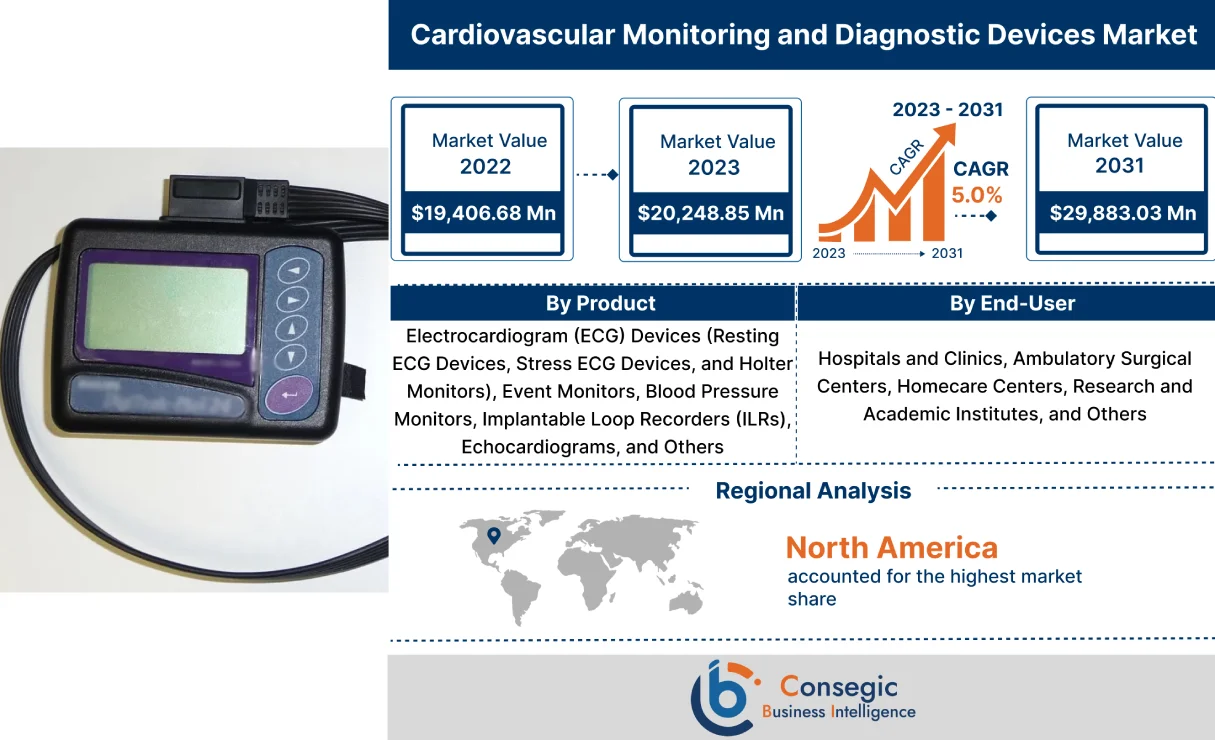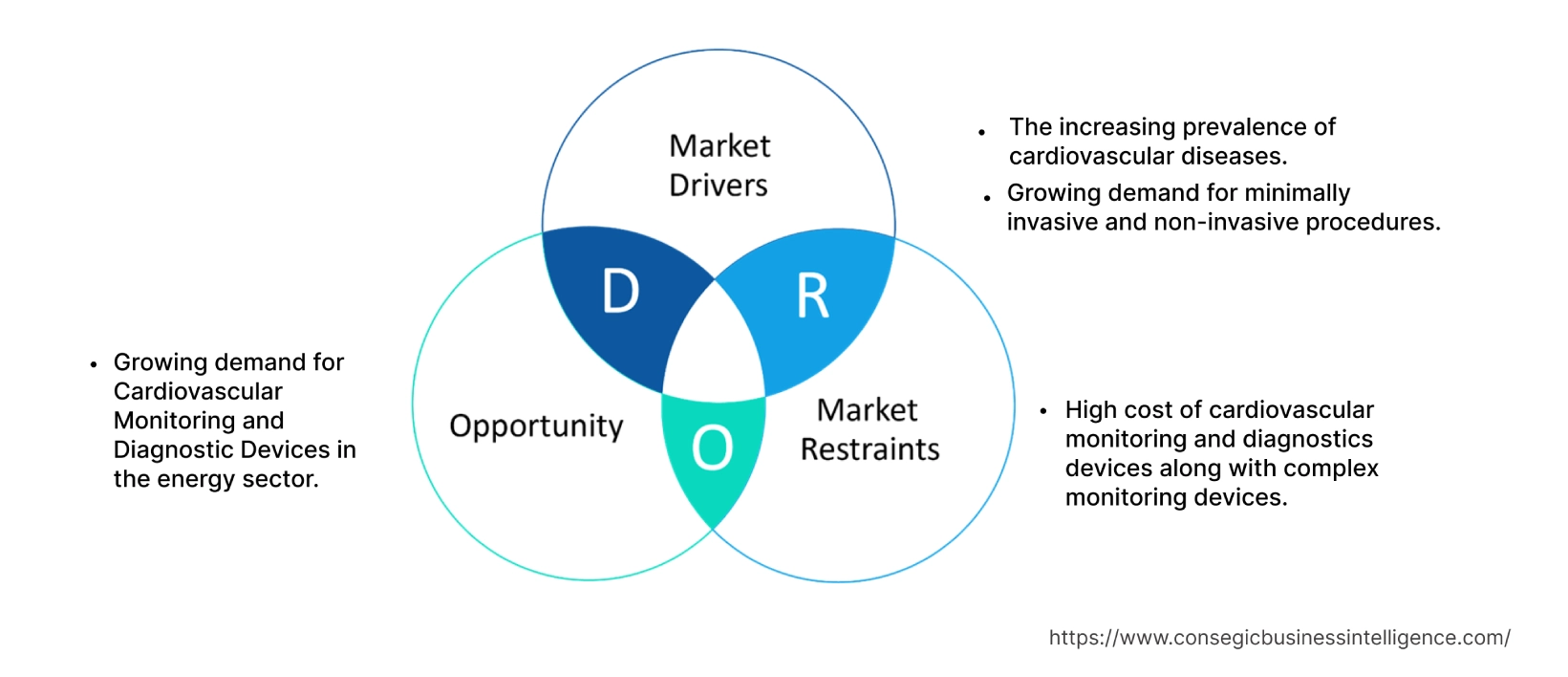Cardiovascular Monitoring and Diagnostic Devices Market Size :
Consegic Business Intelligence analyzes that the cardiovascular monitoring and diagnostic devices market size is growing with a CAGR of 5.0% during the forecast period (2023-2031). The market accounted for USD 19,406.68 million in 2022 and USD 20,248.85 million in 2023, and the market is projected to be valued at USD 29,883.03 Million by 2031.
Cardiovascular Monitoring and Diagnostic Devices Market Scope & Overview:
Cardiovascular monitoring and diagnostic devices are used to measure and record the electrical and mechanical activity of the heart and blood vessels. These devices can be used to diagnose and monitor a variety of cardiovascular diseases, including heart attack, arrhythmia, heart failure, coronary artery disease, congenital heart defects, and high blood pressure.
Cardiovascular monitoring and diagnostic devices can be used to diagnose a variety of cardiovascular diseases, including heart attack, arrhythmia, heart failure, coronary artery disease, congenital heart defects, high blood pressure, and valve disease. Cardiovascular monitoring and diagnostic devices are essential tools for the diagnosis and management of cardiovascular diseases. These devices help clinicians to provide better care to patients with cardiovascular diseases, which can lead to improved patient outcomes.
Cardiovascular Monitoring and Diagnostic Devices Market Insights :
Cardiovascular Monitoring and Diagnostic Devices Market Dynamics - (DRO) :
Key Drivers :
The increasing prevalence of cardiovascular diseases
Cardiovascular monitoring and diagnostic devices are used to diagnose a variety of CVDs, including heart attack, arrhythmia, heart failure, coronary artery disease, congenital heart defects, high blood pressure, and valve disease. Cardiovascular monitoring and diagnostic devices are also used to monitor the progression of CVDs and the effectiveness of treatment. This can help clinicians to make informed decisions about patient care. Furthermore, cardiovascular monitoring and diagnostic devices can be used to identify individuals at high risk of developing CVDs. This information can be used to develop strategies to prevent these diseases from developing. Increasing prevalence of cardiovascular diseases are driving the market growth. For instance, according to the World Health Organization report in May 2023, Deaths from cardiovascular disease have surged 60% globally over the last 30 years. According to a report from the World Heart Federation (WHF), deaths from cardiovascular disease jumped globally from 12.1 million in 1990 to 20.5 million in 2021. Furthermore, according to the report by the World Health Organization in June 2021, Cardiovascular diseases (CVDs) are the leading cause of death globally, in 2019, an estimated 17.9 million people died from CVDs, representing 32% of all global deaths. Of these deaths, 85% were due to heart attack and stroke. Hence, the increasing prevalence of CVDs is increasing the demand for the cardiovascular monitoring and diagnostic devices market and driving the market growth across the globe.
Cardiovascular monitoring and diagnostic devices are used to diagnose a variety of CVDs, including heart attack, arrhythmia, heart failure, coronary artery disease, congenital heart defects, high blood pressure, and valve disease. Cardiovascular monitoring and diagnostic devices are also used to monitor the progression of CVDs and the effectiveness of treatment. This can help clinicians to make informed decisions about patient care. Furthermore, cardiovascular monitoring and diagnostic devices can be used to identify individuals at high risk of developing CVDs. This information can be used to develop strategies to prevent these diseases from developing. Increasing prevalence of cardiovascular diseases are driving the market growth. For instance, according to the World Health Organization report in May 2023, Deaths from cardiovascular disease have surged 60% globally over the last 30 years. According to a report from the World Heart Federation (WHF), deaths from cardiovascular disease jumped globally from 12.1 million in 1990 to 20.5 million in 2021. Furthermore, according to the report by the World Health Organization in June 2021, Cardiovascular diseases (CVDs) are the leading cause of death globally, in 2019, an estimated 17.9 million people died from CVDs, representing 32% of all global deaths. Of these deaths, 85% were due to heart attack and stroke. Hence, the increasing prevalence of CVDs is increasing the demand for the cardiovascular monitoring and diagnostic devices market and driving the market growth across the globe.
Growing demand for minimally invasive and non-invasive procedures.
Cardiovascular monitoring and diagnostic devices are becoming increasingly minimally invasive and non-invasive. This makes them more appealing to patients and clinicians alike. The growing demand for minimally invasive and non-invasive procedures is driving the demand for cardiovascular monitoring and diagnostic devices. Minimally invasive and non-invasive procedures are becoming increasingly popular because they are less risky and have shorter recovery times than traditional open-heart surgery. Furthermore, cardiovascular monitoring and diagnostic devices are used to guide and monitor minimally invasive and non-invasive procedures. For example, echocardiograms can be used to guide the insertion of a stent during angioplasty. Stress tests can be used to monitor the heart's response to exercise during a treadmill test.
The increasing launch of new products in cardiovascular monitoring and diagnostics devices is driving the market growth. For instance, in January 2023, UltraLinQ, a digital healthcare solutions company, launched a new cardiac monitoring product at Arab Health in 2023. The product is an end-to-end patient monitoring concept for diagnosing cardiac arrhythmias. This new product offers a low-cost and end-to-end system that enables hospitals and specialist clinics to provide extended services to patients. Thus, the increasing demand for minimally invasive and non-invasive procedures along with the increasing innovations in cardiovascular monitoring and diagnostics devices is driving the market growth across the globe. The cardiovascular monitoring and diagnostic devices market is expected to benefit from the growing demand for these steels across the globe.
Key Restraints :
High cost of cardiovascular monitoring and diagnostics devices along with complex monitoring devices
Cardiovascular monitoring and diagnostics devices are relatively expensive, especially implantable devices and advanced remote monitoring systems. This deters some patients and healthcare facilities from adopting these devices. Some cardiovascular monitoring devices are complex to use, requiring specialized training for clinicians and patients. This also be a barrier to their adoption. These two factors can limit the accessibility of cardiovascular monitoring and diagnostics devices, especially for patients in developing countries and underserved communities. Additionally, the high cost of these devices can place a financial burden on patients and healthcare systems.
Moreover, Complex monitoring devices may require specialized training for clinicians and patients to use effectively. This can limit access to these devices, especially in underserved communities and developing countries. Furthermore, complex monitoring devices can be more prone to errors if not used properly. This can lead to inaccurate results and misdiagnosis. Thus, the high cost of cardiovascular monitoring and diagnostic devices and high complexity of monitoring devices is restraining the growth of market across the globe.
Future Opportunities :
Growing demand for Cardiovascular Monitoring and Diagnostic Devices in the energy sector
Cardiovascular disease (CVD) is the leading cause of death globally. Early detection and diagnosis of CVD is essential for effective treatment and prevention. Technological advancements in cardiovascular monitoring and diagnostic devices are driving the market growth, as they enable more accurate, efficient, and accessible diagnosis and monitoring of CVD. As the prevalence of CVD increases, there is a growing demand for early detection and diagnosis of the disease. Technological advancements in cardiovascular monitoring and diagnostic devices are meeting this demand by providing more accurate, efficient, and accessible diagnostic tools.
Moreover, Innovation in technologies such as wearable blood pressure monitors which continuously monitor blood pressure throughout the day, provides a more accurate picture of a person's blood pressure than traditional blood pressure monitors, which only take a single measurement at a time. For instance, in August 2023, GE Healthcare announced the launch of Portrait Mobile wireless and wearable monitoring solution, which is a wearable monitoring solution that allows patients to move freely during critical recovery periods. The platform uses patient-worn sensors and a smartphone-sized monitor to provide real-time, personalized views of patient vitals. Thus, increasing innovation in cardiovascular monitoring and diagnostic devices is expected to create lucrative growth opportunities for the growth of the global cardiovascular monitoring and diagnostic devices market over the forecast period.
Cardiovascular Monitoring and Diagnostic Devices Market Report Insights :
| Report Attributes | Report Details |
| Study Timeline | 2017-2031 |
| Market Size in 2031 | USD 29,883.03 Million |
| CAGR (2023-2031) | 5.0% |
| By Product | Electrocardiogram (ECG) Devices (Resting ECG Devices, Stress ECG Devices, and Holter Monitors), Event Monitors, Blood Pressure Monitors, Implantable Loop Recorders (ILRs), Echocardiograms, and Others |
| By End User | Hospitals and Clinics, Ambulatory Surgical Centers, Homecare Centers, Research and Academic Institutes, and Others |
| By Region | North America, Europe, Asia-Pacific, Latin America, and Middle East & Africa |
| Key Players | Medtronic, Boston Scientific, Abbott Laboratories, GE Healthcare, Asahi Kasei Corporation, Omron Healthcare, Hill-Rom Holdings, Nihon Kohden, SCHILLER AG, ACS Diagnostics, Lepu Medical Technology, and Baxter |
Cardiovascular Monitoring and Diagnostic Devices Market Segmental Analysis :
By Product :
The product is categorized into electrocardiogram (ECG) devices, event monitors, blood pressure monitors, implantable loop recorders (ILRS), echocardiograms, and others. The electrocardiogram (ECG) devices are further classified as resting ECG devices, stress ECG devices, and holter monitors. In 2022, the electrocardiogram (ECG) segment accounted for the highest market share in the cardiovascular monitoring and diagnostic devices market, and it is also expected to grow at the highest CAGR over the forecast period. Electrocardiogram (ECG) devices are the most widely used cardiovascular monitoring and diagnostic devices. ECG devices measure the electrical activity of the heart.
The electrical activity of the heart is reflected in the ECG waveform, which is a graph of the electrical voltage over time. ECG devices can be used to monitor the heart health of athletes during training and competition. This helps to identify any potential problems early on and to prevent serious complications. These devices are used to detect early signs of cardiovascular disease in people at risk, such as those with high blood pressure, high cholesterol, and diabetes. This allows for early intervention and prevention of cardiovascular events.
Moreover, ECG devices have become more technologically advanced in recent years, making them more accurate, efficient, and accessible. For example, wearable ECG devices can now be used to monitor heart health 24/7, and remote monitoring systems allow patients to be monitored by their healthcare providers from the comfort of their own homes. Increasing technological innovations in ECG devices are driving the segment growth across the globe. For instance, in June 2022, Philips introduced the first at-home, 12-lead electrocardiogram (ECG) solution for decentralized clinical trials. The solution uses PCA 500 ECG patch data recording technology to help participants record data at home. The solution is designed to improve patient recruitment, compliance, and retention by reducing the need for site visits. The high benefits of electrocardiogram devices along with the increasing innovations in ECG devices are driving the segment growth globally.
By End-User :
The end user segment is categorized into hospitals and clinics, ambulatory surgical centers, homecare centers, research and academic institutes, and others. In 2022, the hospitals and clinics segment accounted for the highest market share of 45.50% in the overall cardiovascular monitoring and diagnostic devices market. Cardiovascular monitoring and diagnostic devices are essential tools for hospitals and clinics. They are used to diagnose and monitor a wide range of cardiovascular conditions, including heart failure, coronary artery disease, arrhythmias, and heart attacks. These devices play a vital role in helping healthcare providers to provide the best possible care to their patients. Various equipment such as electrocardiogram, echocardiogram, stress test, and cardiac catheterization is increasing across hospitals and clinics. The growing hospital expenditures are driving segment growth across the globe. For instance, according to the report by the American Medical Association in March 2023, Hospital expenditures grew 4.4% to USD 1,323.9 billion in 2021, slower than the 6.2% growth in 2020.
Moreover, the homecare centers segment is expected to hold the highest CAGR over the forecast period. Increasing access, improving quality, and lowering the cost of healthcare delivery are driving the segment growth over the forecast period. For instance, according to the report by the Centers for Medicare and Medicaid Services in September 2023, the total healthcare spending by an individual in the U.S. accounted for USD 1,18,434 in 2020. The growing healthcare expenditure across the globe is creating lucrative growth opportunities for cardiovascular monitoring and diagnostic devices over the forecast period.
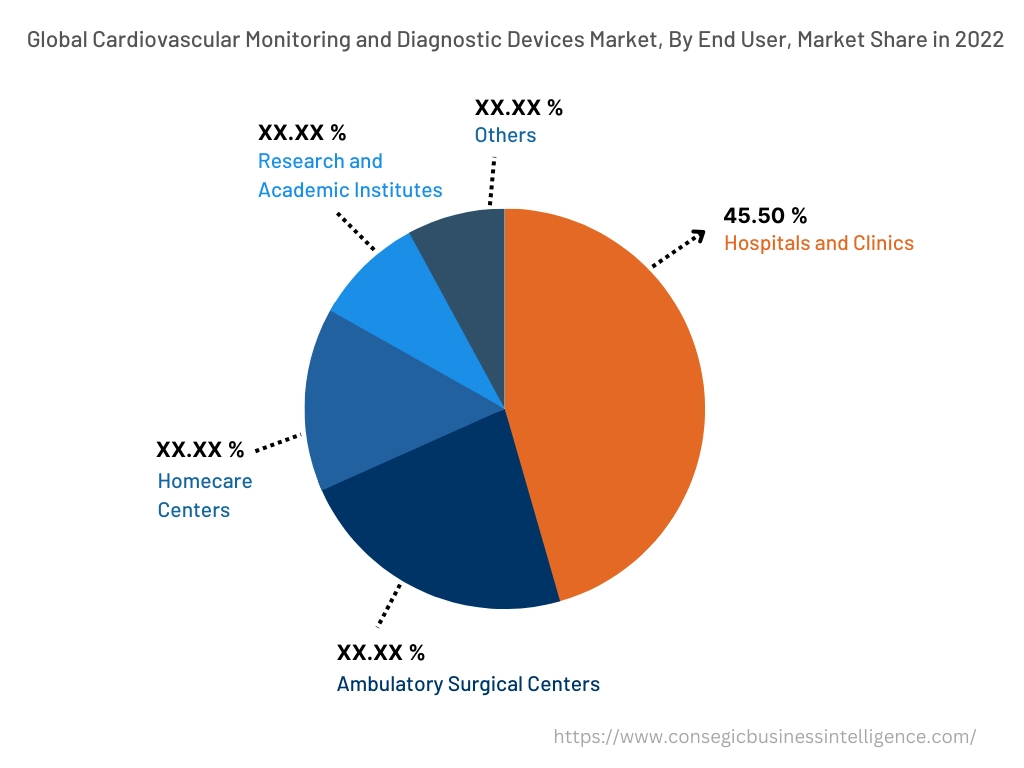
By Region :
The regional segment includes North America, Europe, Asia Pacific, Middle East and Africa, and Latin America.
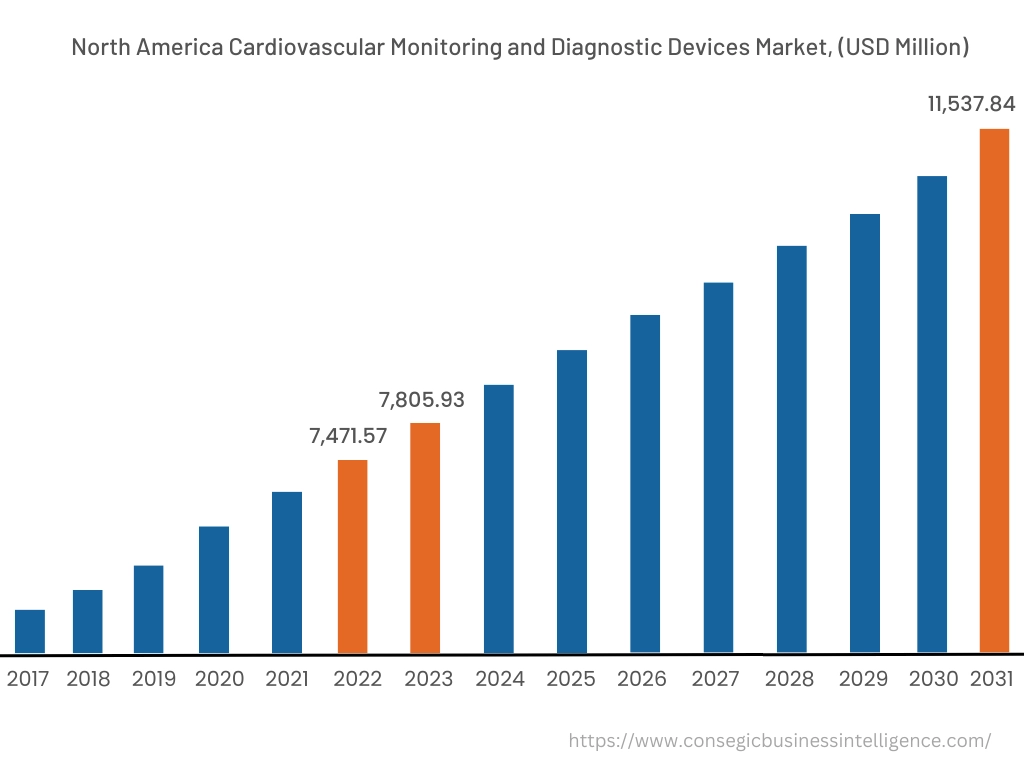
In 2022, North America accounted for the highest market share at 38.50% valued at USD 7,471.57 Million in 2022 and USD 7,805.93 Million in 2023, it is expected to reach USD 11,537.84 Million in 2031. In North America, the U.S. accounted for the highest market share of 65.77% during the base year of 2022. This is due to several factors, including the high prevalence of cardiovascular diseases in the region, the presence of a well-developed healthcare system, and the high adoption rate of new technologies. For instance, according to the report by the American Heart Association in January 2023, in 2020, coronary heart disease (CHD) was the leading cause of death attributable to cardiovascular disease (CVD) in the United States. CHD accounted for 41.2% of deaths. Moreover, increasing investments in the development of cardiovascular monitoring and diagnostic devices across the region is also driving the market growth. For instance, in April 2022, IMPLICITY, a leader in remote patient monitoring and cardiac data management solutions, announced it has raised USD 23 million in funding in series a of funding led by new investors: Crédit Mutuel Innovation and Bpifrance. This new investment expands the company's market presence in the US and supports expansion into the new market. Thus, the increasing prevalence of cardiovascular disease along with the technological innovations in the region are driving the market growth across North America.
Furthermore, Asia Pacific is expected to witness significant growth over the forecast period, growing at a CAGR of 5.6% during 2023-20230. The increasing prevalence of cardiovascular diseases in the region, the rising disposable incomes, and the growing awareness of the benefits of early detection and diagnosis of cardiovascular disease in Asia Pacific is driving the market growth. For instance, according to the National Institute of Health in June 2023, prevalent cases of total cardiovascular diseases in China nearly doubled from 271 million in 1990 to 523 million in 2019, reaching 12.1 million in 2019. Such growing prevalence of CVD along with the increasing consumer awareness regarding detection and diagnosis of CVD are expected to drive the cardiovascular monitoring and diagnostic devices market growth across the Asia Pacific region over the forecast period.
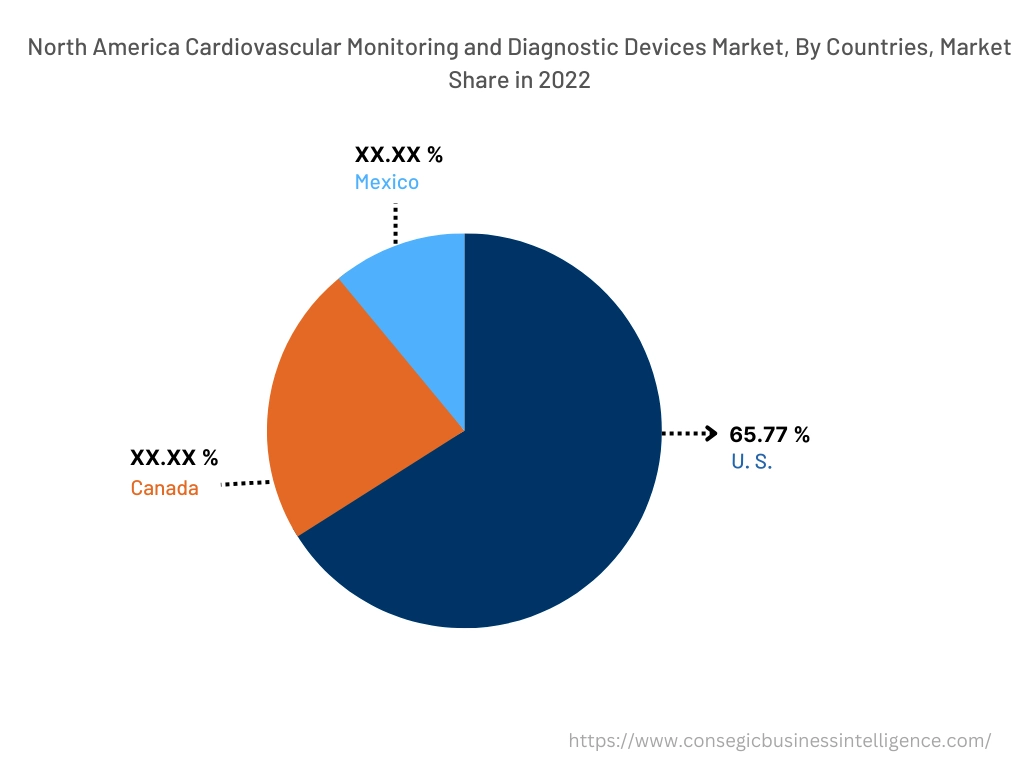
Top Key Players & Market Share Insights:
The cardiovascular monitoring and diagnostic devices market is highly competitive, with several large players and numerous small and medium-sized enterprises. These companies have strong research and development capabilities and a strong presence in the market through their extensive product portfolios and distribution networks. The market is characterized by intense competition, with companies focusing on expanding their product offerings and increasing their market share through mergers, acquisitions, and partnerships. The key players in the market include-
- Medtronic
- Boston Scientific
- SCHILLER AG
- ACS Diagnostics
- Lepu Medical Technology
- Baxter
- Abbott Laboratories
- GE Healthcare
- Asahi Kasei Corporation
- Omron Healthcare
- Hill-Rom Holdings
- Nihon Kohden
Recent Industry Developments :
- In October 2023, Boston Scientific announced the launch of LUX-Dx II+ Insertable Cardiac Monitor (ICM) System which is a small, leadless electronic device that monitors for arrhythmias. It's inserted under the skin in the left pectoral region.
- In February 2023, Abbott Laboratories and Cardiovascular Systems, Inc. (CSI), today announced a definitive agreement for Abbott to acquire CSI, a medical device company with an innovative atherectomy system used in treating peripheral and coronary artery disease. Under terms of the agreement, CSI stockholders will receive USD 20 per common share at a total expected equity value of approximately USD 890 million.
- In December 2021, ZOLL Medical Corporation a subsidiary of Asahi Kasei company that manufactures medical devices and software solutions, announced the acquisition of Itamar Medical Ltd.
Key Questions Answered in the Report
What was the market size of the cardiovascular monitoring and diagnostic devices market in 2022? +
In 2022, the market size of cardiovascular monitoring and diagnostic devices was USD 19,406.68 million.
What will be the potential market valuation for the cardiovascular monitoring and diagnostic devices industry by 2031? +
In 2031, the market size of cardiovascular monitoring and diagnostic devices will be expected to reach USD 29,883.03 million.
What are the key factors driving the growth of the cardiovascular monitoring and diagnostic devices market? +
The increasing prevalence of cardiovascular diseases across the globe is fueling market growth at the global level.
What is the dominant segment in the cardiovascular monitoring and diagnostic devices market for the end user? +
In 2022, the hospitals and clinics segment accounted for the highest market share of 45.50% in the overall cardiovascular monitoring and diagnostic devices market.
Based on current market trends and future predictions, which geographical region is the dominating region in the cardiovascular monitoring and diagnostic devices market? +
North America accounted for the highest market share in the overall market.
